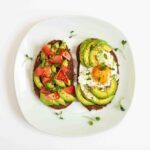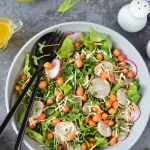Info & FAQ
Frequently Asked Questions about Microgreens
With microgreens you eat only the young plant stem called a hypocotyl, and the “cotyledon” leaves. The first 2 large broad leaf ones as well as the beginning of the “Plumule” are the “cotyledon” leaves.
Vitamin C – Microgreens are known for the abundant amounts of vitamin C they offer. This vitamin is essential in helping your body eliminate free radicals. You can find up to 20 mg per 100 g of this vitamin in the smallest microgreen seedling. Compare this to the 10 mg of vitamin C you find in full-grown tomatoes.
Vitamin E – This vitamin is made up of alpha and gamma-tocopherol. This essential vitamin helps protect your body from damage caused by free radicals formed when we convert food to energy. A small serving of vitamin E rich microgreens like daikon radishes is more than enough to hit your daily requirement of this vitamin. Beta Carotene. Beta carotene is a carotenoid compound that helps to reduce the risk of various diseases. Microgreens are filled with high beta carotene levels, which is why they make such a useful addition to anyone’s diet.
Source: planetnatural.com
Microgreens contain similar and often greater amounts of these nutrients than mature greens. As such, they may similarly reduce the risk of the following diseases:
Heart disease: Microgreens are a rich source of polyphenols, a class of antioxidants linked to a lower risk of heart disease. Animal studies show that microgreens may lower triglyceride and “bad” LDL cholesterol levels.
Alzheimer’s disease: Antioxidant-rich foods, including those containing high amounts of polyphenols,may be linked to a lower risk of Alzheimer’s disease.
Diabetes: Antioxidants may help reduce the type of stress that can prevent sugar from properly entering cells. In lab studies, fenugreek microgreens appeared to enhance cellular sugar uptake by 25–44%.
Certain cancers: Antioxidant-rich fruits and vegetables, especially those rich in polyphenols, may lower the risk of various types of cancer. Polyphenol-rich microgreens may be expected to have similar effects.
Source: healthline.com
Nutritionally, microgreens prove that great things can come in small packages. “Research suggests that younger leaves of plants can have higher levels of certain vitamins and antioxidants than more mature plants,” says Sharon Palmer, R.D.N., author of The Plant-Powered Diet.
Source: runnersworld.com
The most popular ways to use microgreens are:
- Seasoning soups.
- Layering in sandwiches.
- Garnishing drinks.
- Mixing into salads.
- Juicing them.
- Adding to a stir fry.
And much much more! I personally love adding them to my smoothies and as a pizza topping to add flavor and much needed vitamins to my diet.
Our Popular Varieties
We want to see what you do with our greens! Tag us on Instagram with #GSFGreens for a shoutout!





Frequently Asked Questions about Granite State Farm
Granite State Farm is located in Whitefield New Hampshire.
We soruce our non-GMO seeds from certified seed suppliers in North America such as www.Johnnyseeds.com, and www.highmowingseeds.com . We also don’t use any pesticides on or near our greens to insure the best quality microgreens for your enjoyment!
Granite State Farm (GSF) has a goal to be completely carbon neutral in 2024 and a goal to reach 80-90% in 2023. GSF was started in July of 2021 and we are currently 10.6% carbon neutral.